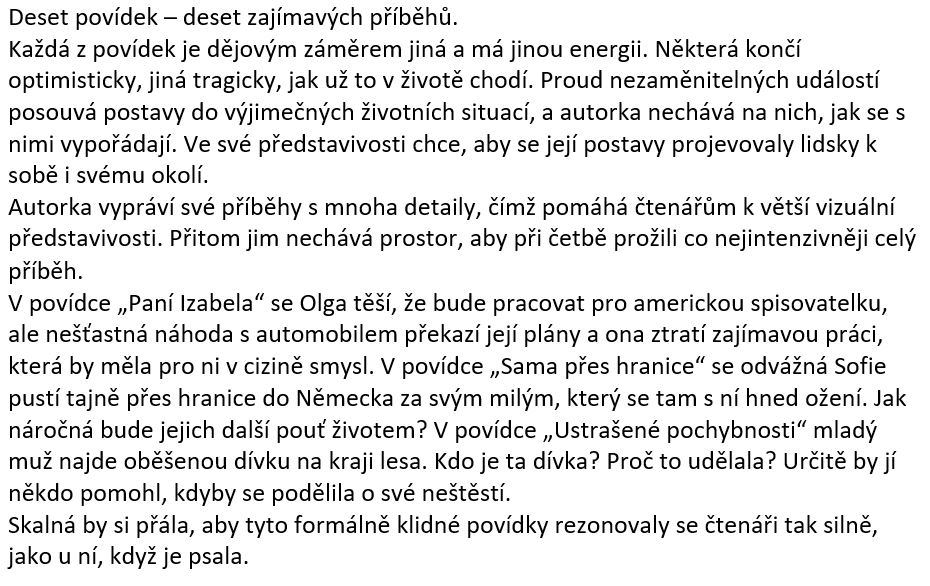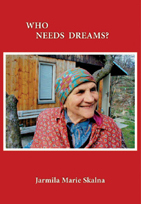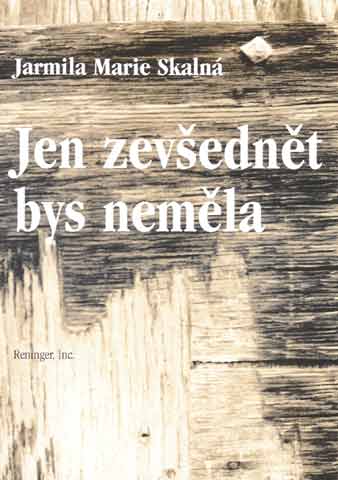| |

Books
Zrychlené okamžiky
Nora
Who
Needs Dreams?
Striding
into the Sun
Jen
zevšednĕt bys nemĕla
Modrý
kovboj a žlutá kráva
Chodící
hůlka
|
Zrychlené okamžiky
Reninger,
2022, ISBN-13: 978-0-9635388-6-4





Nora
Reninger,
2013, ISBN-13: 978-0-9635388-5-7

This
is a story about an eighteen-year old girl, named Nora and her communication
with herself, her surroundings and the astral world. Nora is deeply
disappointed when her parents stop understanding her and each other.
She relies on her cousin, Vik, who believes that good human relations
must first be programmed. Nora, however has a feeling that she has
been programmed by everyone. Within her, she wishes to be closer
to her younger brother, Otik, her aunt, Irena, her friends, Borek
and Richard, and a few classmates. Should she follow them or avoid
them? She is a rebel who does not like to accept something that
she has not personally experienced. She looks up to her mentor,
Quisto, who leads her into the astral world where she finds other
family members and names them Neons. She communicates with them
about what is happening around her. However, the reality of everyday
life is different than that of the astral world. Gradually, she
realizes that she cannot just follow someone advice, but has to
find her own way in life. Will she have enough strength?
Who
Needs Dreams?
Reninger,
2007, ISBN-10: 0-9635388-4-5; ISBN-13: 978-0-9635388-4-0

Readers who
are familiar with the Czech author Jarmila Marie Skalna’s
first book written in English, Striding into the Sun, will
definitely want to read her newest book, Who Needs Dreams?
– another beautifully-written and wonderful, or,
better, wonder-filled, collection of stories about ordinary, but
fascinating, people whom Skalna has had the privilege of meeting.
It all adds up to a delightful collection of stories filled with
the dreams referred to in the book’s title. Who needs dreams?
Why, of course, we all need dreams for what would life be without
dreams if not a prison?
Skalna’s
stories always surprise me by the way they reveal the dreamlike
character of ordinary life. Reading her stories, one realizes that
the prison of boredom that we often lock ourselves up in is a prison
of our own making, one that we can escape if we only have the imagination
to dream and the wisdom to listen to the dreams of others. When
I finish reading a story by Skalna I always wonder about one of
my next door neighbors or a stranger I pass by on the street or
the clerk in some department store – what is their story?
What strange dreams stir within their skulls that will remain forever
hidden from daylight unless some writer like Skalna with a gift
for words and the love for the ordinary gets a hold of these and
magically transforms these into poetry--using poetry as a name for
all creative literature.
Here are a
few of the many dreamers who brighten up the pages of Skalna’s
book. There is Jennifer, a young women whom Skalna befriends, who
wants to learn Czech so she can flirt with Czech hockey players
in their language and who waits patiently outside the hockey arena
to greet a Czech player in person. There is the eighty-nine-year-old
Manuel, who has exciting stories to tell about his life in Mexico
where he produced films, played chess with John Wayne, and escaped
from bandits who were trying to rob his car. There is Debby, who
tells the story of the day she stopped liking roses and whose memory
is haunted by the death of her daughter years ago who was killed
by a crazy hippy. There is Anne Delaney, S.F.O., songwriter and
soprano, who was inspired to compose "King of Hearts"
and traveled from Menlo Park, California, on pilgrimage to Prague
to pray, sing, and hear her hymn premiere in Czech for the Feast
of the Infant Jesus of Prague in Our Lady Victorious Church.
In all, there
are seventeen beautifully written stories, full of humor, compassion,
and drama that are just waiting for the reading public to discover.
“The dead trees whisper their stories to me,” says Skalna—and
oh what stories.
—RICHARD
HAMMERUD, Ph.D.
[Richard
Hammerud has a Ph.D. in English from the University of California
at Berkeley and a Ph.D. in Philosophical Theology from the Graduate
Theological Union. He currently teaches at the College of San Mateo
and at De Anza College in Northern California.]
| Striding
into the Sun
Reninger, 2006, ISBN-10: 0-9635388-3-7;
ISBN-13: 978-0-9635388-3-3

This
is Skalna's first book in English; until now her books have
been written in her native language, Czech. After I read the
book, I wanted to go back and read it again to refresh my
memory about the interesting group of characters I had been
introduced to, but also to simply reread certain passages
for the beauty of the language, which is always very clear,
very simple, and very imaginative. Realism and fantasy converge
effortlessly in her stories, suggesting that there is more
to reality than meets the eye and that dark, mysterious, terrible,
and, yes, beautiful surprises await us foolish mortals at
every turn.
Each
of the twenty-one stories draws the reader into "an
enchanting circle" of an ordinary or not so ordinary
human being, into whose life we are allowed to peek for a
few moments, before we come away with an increased appreciation
for the little things in life - whether it be for the baby
frogs Skalna rescues from dried-up mud, for her writing teacher,
Laura, who taught her to remember three things wherever she
went, and to write them together in her stories, for an imagined
conversation with Papa Hemingway (an author, Skalna tells
us, whom she dreams about), for watching a man fly a colorful
kite at Seacliff Beach while his little dog is chasing it,
for walking down Santa Cruz Avenue and falling in love with
the picture of a cow called Bessie, for having a beer with
the Czech poet Bohumil Hrabal, for finding a yellow cow and
then seeing it jump over a silver moon, for being a nanny
in a strange land and learning to get along in English, for
encountering a native American playing a harmonica beneath
an oak tree, for accompanying her seventy-eight-year-old friend
Amy to the hospital and then finding out that the young doctor
had lost the skin-sample he had taken and being told that
they must come back again in two weeks, for taking a train
ride to the Davies Symphony Hall in San Francisco for an opening
rehearsal of Beethoven's Missa Solemnis, for befriending
an elderly Czech woman, Sophia, and listening to her tell
about the thirteen cats she has to take care of, to, well,
we can go on and on.
Each of these stories is recounted with compassion, humor,
wisdom, and a loving care for detail that makes the reader
want to revisit them again."
—RICHARD
HAMMERUD, Ph.D.
[Richard
Hammerud has a Ph.D. in English from the University of California
at Berkeley and a Ph.D. in Philosophical Theology from the
Graduate Theological Union. He currently teaches at the College
of San Mateo and at De Anza College in Northern California.]
"This
is a mostly lovely series of very short stories and vignettes,
some dealing with Hemingway, some with writing, some with
nature, most illustrated by interesting photographs or drawings.
What's most remarkable is that these are written in English,
which is Skalna's second language. She has a gift for elegant
phrasing. She has a command of our language that many native
speakers do not have. Skalna's writing is often beautiful,
and most of the stories are precisely the length they should
be—a skill to be praised highly."
—WRITER'S
DIGEST
[
Judge's commentary]
"...a
consistently charming collection of essays and friendship
tales from the heart of a writer who sees the world through
gentle but honest eyes. Jarmila Marie Skalna's insights are
thought-provoking, and all the more remarkable because she
writes them in her second language. Ms. Skalna's work come
close to home...in more ways than one."
—ROGER
WELSCH
[A writer from Nebraska]
Jen
zevšednĕt bys nemĕla
(You
Should Remain Special)
Reninger,
1998, ISBN 0-9635388-2-9

Skalna
weaves an interesting tale, which is both humorous and sad.
It gradually creates a mosaic of a human story, which reflects
deep and penetrating thoughtfulness.With a vision of new life
in America, Laura is looking for her own self-realization.
New friendships develop in contrast with her own memories
of home. She experiences an on-going transformation of her
personality that appeares to be positive and which seems to
move her ahead. Laura realizes that every experience, though
sometimes negative, is important and had to be fully integrated
into her whole.
Modrý
kovboj a žlutá kráva (Blue
Cowboy and a Yellow Cow)
Obzor Jihlava, 1995, ISBN 0-9635388-1-0

A reference
to the impressionistic period (a yellow cow from a picture
by Franz Marc, and a blue cowboy as an example of a poetic
symbol). The emotional entries flow freely, especially where
the writer is speaking of a relatively new American reality. The
essence of man is explored in a slightly fictitious way, taking
place not only in a single setting, but also through different
periods of time. The poetic scriptures refer to the various
dimensions of this Earth and human destiny. The text is filled
with inventive words and expressions, but the mood suggests
an underlying feeling of homesickness.
—OLDRICH
ŠULER
[A
Czech writer]
Chodící
hůlka aneb
Menší velká cesta za Hemingwayem (The Walking Stick: A Homage
to Hemingway)
Reninger, 1993, ISBN 0-9635388-0-2

Contains the
writer’s journey in the footsteps of Hemingway on land and
at sea, off the coast of Florida
and Cuba,
through the regions of Peru
with their rich history dating back thousands of years. One
would be wrong to expect this to be a book of travels. It
is more like a topography of fantasy in confrontation with
realistic impression. This appeals to the author, as can be
seen in similarities to Ernest Hemingway’s style, the interwoven
stories of this deeply experienced journey, and the nostalgic
memories of childhood places in Moravia.
|
| |
|











